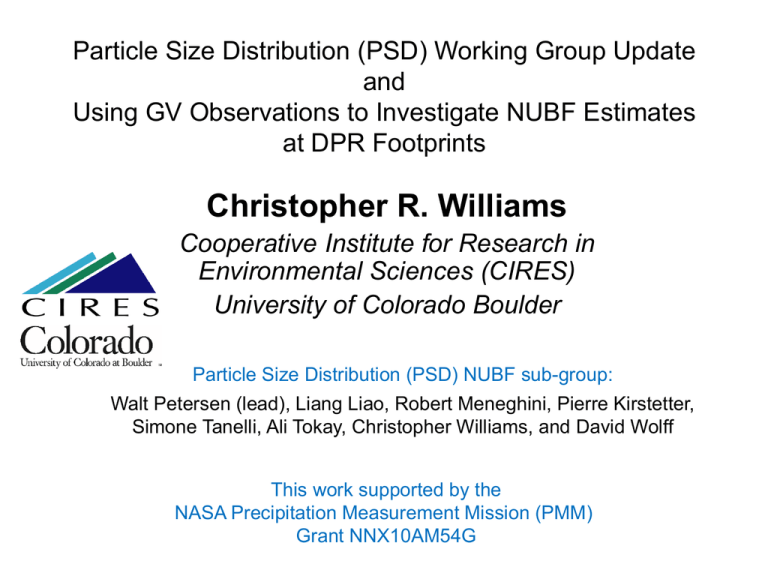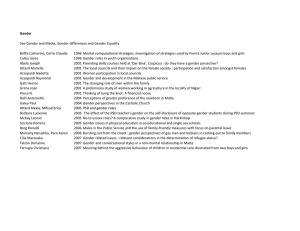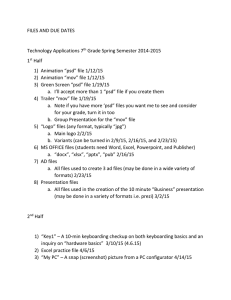Vertical Structure of DSD Parameters Retrieved from Profilers
advertisement

Particle Size Distribution (PSD) Working Group Update and Using GV Observations to Investigate NUBF Estimates at DPR Footprints Christopher R. Williams Cooperative Institute for Research in Environmental Sciences (CIRES) University of Colorado Boulder Particle Size Distribution (PSD) NUBF sub-group: Walt Petersen (lead), Liang Liao, Robert Meneghini, Pierre Kirstetter, Simone Tanelli, Ali Tokay, Christopher Williams, and David Wolff This work supported by the NASA Precipitation Measurement Mission (PMM) Grant NNX10AM54G NASA PMM DSD Working Group: Bridging Ground Validation (GV) and Algorithms PSD Working Group GV Data Ground Validation Particle Size Distribution (PSD) (August 2014) Algorithm Development Future Field Campaigns PSD WG General Objective: Use Ground Validation (GV) data to support, or justify, assumptions used in satellite retrieval algorithms. Today’s Outline: 1) Accomplishments of DSD Working Group 2) Describe 5 PSD sub-groups & their focus to improve retrieval algorithms 3) Highlight activities in Non-Uniform Beam Filling (NUBF) sub-group PSD Working Group Monthly phone calls: 3rd Thursday @ 11 AM Eastern (US). Accomplishments of DSD WG Normalized breadth – independent of Dm Broad Narrow Gamma shape parameter Mass spectrum breadth Using surface 2DVD observations, calculated joint PDFs of DSD parameters vs Dm. Provides expected value and range of DSD parameters for probabilistic retrieval algorithms. Gamma shape & slope parameters Williams, Bringi, Carey, Chandra, Gatlin, Haddad, Meneghini, Munchak, Nesbitt, Petersen, Tanelli, Tokay, Wilson, and Wolff 2013: Adaptive Raindrop Size Distribution Constraint for Probabilistic Rainfall Retrieval Algorithms, submitted to J. Appl. Meteor. Climatol. Radar Integral Tables Adaptive power-law constraint being tested in combined algorithm. From Joe Munchak DFR = Dual Frequency Ratio DWR = Dual Wavelength Ratio 1.5 𝜎𝑚 = 𝑎𝜎𝑦 𝐷𝑚 1 −4 𝑐𝑜𝑛𝑠𝑡𝑟𝑎𝑖𝑛𝑡 𝜇 = 2 𝑎𝜎𝑦 𝐷𝑚 𝑐𝑜𝑛𝑠𝑡𝑟𝑎𝑖𝑛𝑡 𝑎𝜎𝑦 ranged from 0.11 to 0.47 (very narrow to very broad) (Limits of integration = 3*Dm) (Spherical drops) Broad Black line: mu = 2 Narrow Radiometer Integral Tables Adaptive power-law constraint being tested in combined algorithm. From Joe Munchak Parameters needed for radiative transfer calculations are also integrated over the same DSD with the same code to ensure consistency between radar and radiometer algorithm modules. Narrow (𝑎𝜎𝑦 = 0.11) Broad (𝑎𝜎𝑦 = 0.47) Improved Working Group Focus & Leadership • To include solid precipitation, change name of working group: – Particle Size Distribution (PSD) Working Group • 25 members & 30 associate members • Improved Leadership: – Christopher Williams – DSD parameter relationships and column observations – Steve Nesbitt – building the column and moving to aircraft observations – Joe Munchak – algorithm prospective and issues with ice & frozen PSDs PSD Sub-Groups (Defined August 2014) Themes for NASA PMM PSD Working Group • Light & Heavy Rain Estimation • Melting Layer Characteristics • Non-Uniform Beam Filling (NUBF) – PIA(Ka) / PIA(Ku) Relationship – Chandra – Ben Johnson – Walt Petersen – Christopher Williams • Solid Precipitation – Steve Nesbitt • DSD / PSD Parameter Relationships – Brenda Dolan Impacts of NUBF on DPR Retrieval Algorithms Definitions • Non-Uniform Beam Filling (NUBF) – Non-homogenous rain in IFOV • NUBF affects not only measured Z within radar resolution volume, but affects signal attenuation to that resolution volume Impacts • Severity of NUBF impact depends on the specific method in question & whether it is a single- or dual-frequency retrieval – NUBF probably affects the Ka-band more strongly than the Ku-band – Methods that use the SRT will be affected in a different way than nonSRT methods Background (Theory) • Toshio Iguchi’s NUBF correction theory (2009) is rigorous & elegant • Assumptions in NUBF theory: 1. 2. Assumes k and Z are constant with range (maybe valid at nadir, but not off-nadir) Critical parameter is coefficient of variation in k: CV(k) = std(k) / Expected value(k) How can GV Observations help Evaluate NUBF? Can GV Observations support or improve upon Iguchi’s NUBF correction theory? Topics discussed in NUBF sub-group: • PIA ratio: PIA(Ka)/PIA(Ku) – PSD variability (homogenous rain) – NUBF variability • Quantify sub-grid DPR rain variability using GV radars (network radars) – Large datasets to get good statistics of different rain regimes • 3D structure – Horizontal structure • Correlation length across multiple FOVs – Vertical structure • Relationships between horizontal & vertical structures – View angle dependence (slant view through vertical structures) • Analyses need to include DSD parameters to get attenuation estimates at Ku and Ka Rain-free Surface Reference Aj Z m,ij Surface Return Zˆ m,i Aj Large data base to get statistics across different rain regimes Relative NUBF = std(R) / Rref Pierre Kirstetter et al. (QJRMS 2014) WFF NPOL Moderate Convection and GPM DPR Examine roles of beam geometry, filling, microphysical variability on products B B A A A NPOL, KDOX and DPR well- matched in ice @ (7-10km) Differences in strong convective cells where NPOL reveals that small hail, graupel and large drops exist B NPOL Observations (Wallops Island) from 07-Sept-2014 High resolution data to investigate horizontal & vertical structure RHI scan 5 x 0.5 km grid boxes Mean(Z) Raw obs. Std(Z) vs. mean(Z) Std(Z) Combining Ku-PR NS, Ku-PR MS and Ka-PR HS Simone Tanelli & Steve Durden International Partnerships Themes for NASA PMM PSD Working Group • Light & Heavy Rain Estimation • Melting Layer Characteristics • Non-Uniform Beam Filling (NUBF) – PIA(Ka) / PIA(Ku) Relationship – Chandra – Ben Johnson – Walt Petersen – Christopher Williams • Solid Precipitation – Steve Nesbitt • DSD / PSD Parameter Relationships – Brenda Dolan Solutions Require International Partnerships • How can PSD WG help international partners? • How can International partners help the PSD WG?



